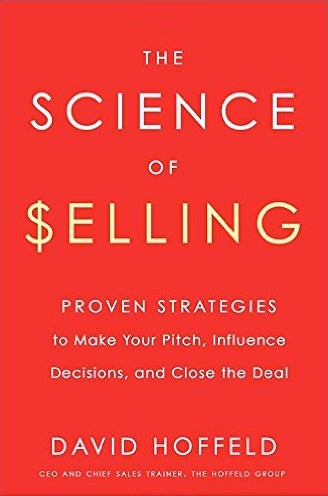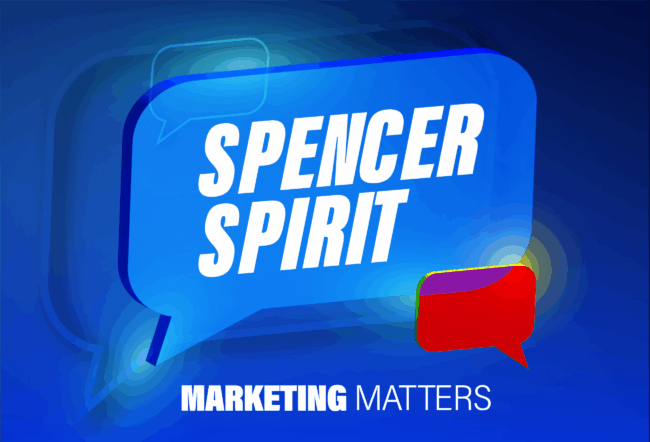 David Hoffeld, CEO of the Hoffeld Group, a sales training firm, believes in taking a scientific approach to selling. His selling strategy is based on disciplines such as social psychology, neuroscience and behavioral economics to understand what makes customers buy. Hoffeld recently spoke on the Knowledge at Wharton show on Sirius XM Channel 111 to talk about his book, The Science Of Selling: Proven Strategies to Make Your Pitch, Influence Decisions and Close the Deal.
David Hoffeld, CEO of the Hoffeld Group, a sales training firm, believes in taking a scientific approach to selling. His selling strategy is based on disciplines such as social psychology, neuroscience and behavioral economics to understand what makes customers buy. Hoffeld recently spoke on the Knowledge at Wharton show on Sirius XM Channel 111 to talk about his book, The Science Of Selling: Proven Strategies to Make Your Pitch, Influence Decisions and Close the Deal.
Knowledge at Wharton: Behavioral economics is driving a lot of research into being a better salesperson these days.
David Hoffeld: You’re absolutely right. I always tell everyone there’s never been a more exciting time to be in sales because of this explosion of scientific research from disciplines like behavioral economics, neuroscience, social psychology and cognitive psychology. It’s the entire reason I do what I do.
I’ve been in sales for quite a while, but it was about 12 years ago that I stumbled on an academic journal. I read it and began to apply it in my sales career and for those I was managing. I saw such results that I developed an odd hobby of reading academic journals and applying them into the world of sales.
Fast forward to today, the book is based on over 1,000 different studies and gives salespeople verifiably effective behaviors that produce real-world results.
Knowledge at Wharton: So, the light went on when you read that first journal?
Hoffeld: It did. It was a wake-up call for me. I had always been a student of sales training, but most of it was based on anecdotal evidence or it almost seemed you were just supposed to do what the trainer said. There was never a why we should do one thing versus another. This research allows salespeople to literally sell in the way their potential customers’ brains are wired to be influenced and how they create buying decisions. In short, it helps people make confident buying decisions that are in their best interests and also yours.
Knowledge at Wharton: You talk about the fact that salespeople don’t relate themselves to the people that they’re trying to sell to or really get an idea as to what makes their customers tick.
Hoffeld: Unfortunately, it’s how they’re trained. A lot of the way that sales ideas have been based on is best practices. There’s nothing wrong with best practices, but when an entire methodology is based on it, whom are we focusing on? We’re focusing on ourselves when we develop best practices. We’re trying to innovate by looking in the mirror, and that doesn’t work. Whom should we be focused on when selling? Our buyers.
“This research allows salespeople to literally sell in the way their potential customers’ brains are wired.”
The science-backed approach is so exciting because it really aligns our focus with whom it should always be on: our buyers. How do we meet their needs? How do we truly understand them, what they need, the problems they want solved, how they’re making decisions? And then how do we sell because of this?
Knowledge at Wharton: Why do you think it has taken so long for this shift in the thought process of selling to take place? Was it all of the research that has been the push?
Hoffeld: That’s a very important question. For a variety of reasons that we talk about in the book, sales has not been embraced in the last 60, 70 years by academia the way marketing has. Most colleges, even community colleges, have classes and degrees in marketing. Sales has very, very few. So, there really hasn’t been research in the world of sales.
There is a price to be paid to do this originally. For example, my firm spent over a decade looking at these academic journals and reading them and then applying it. It’s a very tedious, arduous task. All these results were hidden until recently because they were put away in academic journals and salespeople weren’t reading them. The good news is they’ve been brought out of academia, dusted off and applied to the real world. Now they’re understandable, very practical, and any salesperson or business can use these strategies to instantly improve their effectiveness.
Knowledge at Wharton: With some types of purchases, the emotional attachment that a person has to the item is very important. Buying a car. Buying a home. You say it’s also the recognition that emotions are an important part for the salesperson.
Hoffeld: We’ve all known in the world of sales that emotions matter, but until recently we couldn’t prove it. Or we didn’t know what to do about that, so we acknowledged it and move on with our lives. But because of some breakthrough research in neuroscience, we have a great understanding now of how emotions impact decision-making. What they do is they allow us to create preferences. One neuroscientist put it this way: it’s the logical part of your brain that allows you to look at a person walking towards you and say, “She is my cousin.” But it’s your emotions that allow you to then say, “And I can’t stand her.” It’s the emotions that allow us to create those preferences. Emotions aren’t just involved in the decision process, they determine whether we choose in one direction or another.
Knowledge at Wharton: You talk about options as well. There’s the notion that too many options can backfire. But in the case of sales, having at least one or two options ends up being a positive.
Hoffeld: The research shows both sides of that. The reality is our brains can easily get confused, and too many options drive down sales results. We talk about that. But only showing one option also drives down sales results. One of the studies we talk about in the book was done by Daniel Mochon and published in the Journal of Consumer Research. He showed one option to shoppers and asked if they would purchase it, and 10% did. When he introduced a second option and allowed them to choose, 34% chose the original option, and 32% chose the second option. So, buying behavior went from 10% to 66%.
“The science-backed approach is so exciting because it really aligns our focus with whom it should always be on: our buyers.”
The reason is because our brains naturally do comparisons. When you only have one option, it’s very hard for your brain to compare it to say, is this a good product or bad product? A good price or a bad price? When you add that second option, it eases the cognitive load of the comparison, making it far easier for your brain. Once your brain does that comparison and selects a winner of the two options, it lowers the assignment of risk with now purchasing that option.
Knowledge at Wharton: But it also takes out your competition because if you’re giving somebody a couple of options in your business, then it doesn’t allow them to consider an option from another entity.
Hoffeld: That’s a very valid point. There are so many strategies that you can use that are really aligned with how our brains make choices. Another one is by sharing what other people, who are like your potential customers, did in the same situation. We are very persuaded, the research shows, by people just like us who have experienced similar issues and what they choose because that lowers our assignment of risk as well with following in their footsteps.
I always tell companies and salespeople, think about some of your successful customers. What were the issues they were struggling with? Then after they purchased your product or service, what were the results? When you have a potential customer who’s similar to one of those success stories, share that. That can be extremely powerful and really help people understand the benefits they’re going to experience of your product or service.
Knowledge at Wharton: Do salespeople sometimes lose their perspective, which ends up causing them to lose the sale? They’re not focusing enough about the person and just thinking about their bottom line?
Hoffeld: I think that happens a lot of times, and I think it’s because oftentimes we’re so focused on ourselves. The way to be successful in sales and in business is really to focus on other people. This is one of the things that the science shows and we teach to our clients. For example, one of the biggest questions I get is, how do I create new customer relationships? What do I do? How do I break through the ice regardless of the method I use?
Too often in sales, we begin by saying things like, “If I could have a few minutes of your time to ask you some questions just to see if our product or service might be able to help you in some meaningful ways.” Of course, everyone rejects that idea because we don’t want to go fishing for value.
What I always tell them is “leverage reciprocity.” What is reciprocity? It’s a social norm that says we should repay others for what they’ve done for us. We want to begin by giving value. Don’t ask for things, give things. What is a meaningful insight? Perhaps it’s a white paper or an article, a blog post, something you found in the research about their organization, something you can give them for free that has a high level of value and demonstrates your expertise.
“We have a great understanding now of how emotions impact decision making.”
Once you start with giving, people are now going to reciprocate. They’re very likely now to answer your questions honestly because they feel this psychological debt. Reciprocity has been shown to boost sales, in some cases, by over 100%. It is extremely powerful. It keeps our focus on whom we should always be focused on, our customer, and giving value on every sales call.
Knowledge at Wharton: You believe that following a lot of these methods and scientific research also can make you a better boss in terms of how you deal with your employees.
Hoffeld: When you are in a managerial position, you are about guiding change and fostering motivation and really not getting in the way of it. The great news is there is so much science in this area. How do we guide people in embracing change? That’s always a challenge for managers. How do we continue to foster motivation, and perhaps even a bigger question, how do we not demotivate people? How do we coach them? How do we hire the right people?
We talk about this a little bit in the book. What are the core predictors of heightened levels of sales performance? We now know what those are.
It’s such an exciting time to be in sales and business because this scientific data takes the guesswork out. No longer must we guess our way to success. Now armed with this research, we can make decisions that are accurate and in the best interest of ourselves and those we serve.
Knowledge at Wharton: Part of advancing this is that people must take time to delve into the research. Unfortunately, we’re living in this fast-paced world [and don’t do it enough].
Hoffeld: That’s the exact reason why I wrote the book. We wanted to make this very practical, easy for people to understand. My book is not a textbook, though it’s backed by science and there are over 400 different citations if you want to find and follow the trail to get into the actual research. But we make it understandable, very easy to apply. One of my goals in writing the book was to take this science and make it so that as soon as someone puts that book down, they can instantly begin to use this to make them more effective in their business.
Knowledge at Wharton: How important is the data that we see out there to this whole process?
Hoffeld: It’s changed the game in many ways. Not only now can we have a lot of data about our customers, but they have a lot of data about us as well. Anyone can do a Google search and find out you and all your main competitors. It’s created the hyper-competitive marketplace. It has made what a salesperson does more important than ever because you can’t hide your competitors anymore. When I first got into sales, oftentimes people didn’t know who the main competitors were in my space because there was no way of knowing.
We all have to upgrade our skills and abilities because it is a hyper-competitive world we’re in. Oftentimes, it’s not the best product or service that wins, it’s the best salesperson because we create the perception of that company, the final perception that nudges people over the edge and helps them choose one way or another. So, the way you sell matters now more than ever before.
Knowledge at Wharton: And this is all the way up and down the chain of sales? All the way from the Fortune 500 company down to the people that are selling mattresses at the local store?
Hoffeld: That’s exactly right. The great thing is this science can be applied to any sales environment. We work with Fortune 500 companies, and we’ve also worked with small businesses that just have a single person, that are startups, and it doesn’t matter. Everyone can get better. Armed with the scientific data, we can now improve anyone’s sales performance, even those who don’t think they’re natural salespeople, because we’ve codified these behaviors. Selling is a skill that can be learned by anyone. We know the behaviors that will help you literally sell the way your potential customers create buying decisions.
“No longer must we guess our way to success.”
Knowledge at Wharton: What’s the key then for salespeople to get that close?
Hoffeld: The key is to focus on what comes well before it. Oftentimes in sales, we get seduced by the close. We think that what happens there is what prompts the sale. It’s not. Every piece of research shows that there are certain commitments our brains must make. And if we make them, we’re very likely to say yes at the end of the sale. If we don’t, we won’t.
The way I look at selling is really a series of incremental commitments that guide our potential customers on a progression of consent, naturally advancing the sale, and leaning them into that final decision to purchase, because that’s how our brains make big choices. We first make small ones that are aligned with the big ones; that’s how our brains construct them. We think of commitments as literally the building blocks of the sale.
That’s an important thing because oftentimes our potential customers hate the close because they feel pressured. Why? Because they’ve been sold to badly. They’ve been sold to in ways that conflict with how their brains make choices. Their brain doesn’t make one big decision at the end of a persuasive request, it makes it throughout that request.
We need to begin to look at instead of how do we want to sell, how does the brain make a decision? How can you help your potential customers make that choice? How do you make it easier for them so they walk away feeling good about their decisions? They feel confident in them? That you get loyal happy customers? The way you sell makes such an impact on that.
Knowledge at Wharton: What about the type of communication that salespeople will have with a particular customer, whether in person or on the phone or via email? It may end up being a combination of all three.
Hoffeld: It often is. The mode of communication, no doubt it matters. There are some things happening when you’re face to face that are different on the phone that is highly influential. But the good news is these scientific principles supersede all of that because they’re based on how our brains work. You can apply them in your own environment. For example, in the book we show you exactly how to do this with real-world examples. We have exercises that walk you through, how do I take this science, these ideas, these strategies and use them today to make me more effective so I can better serve my customers?



